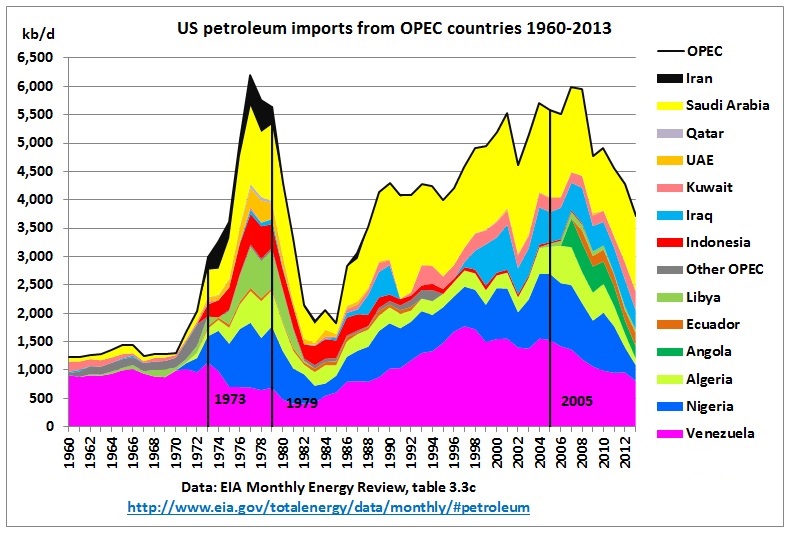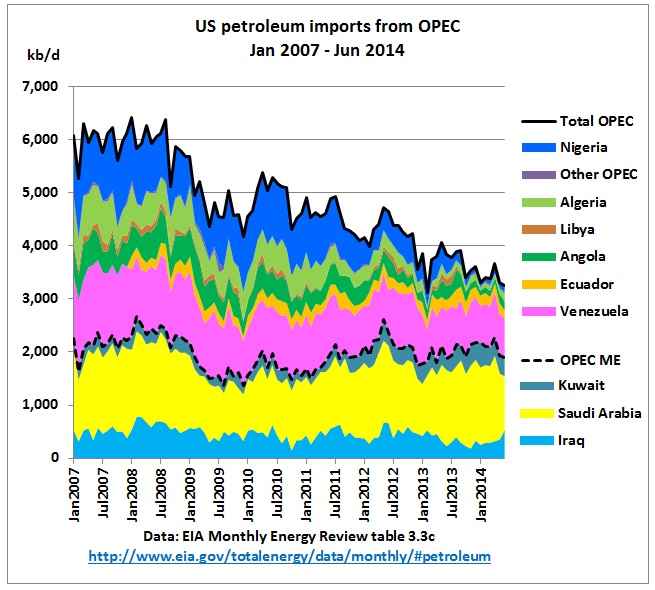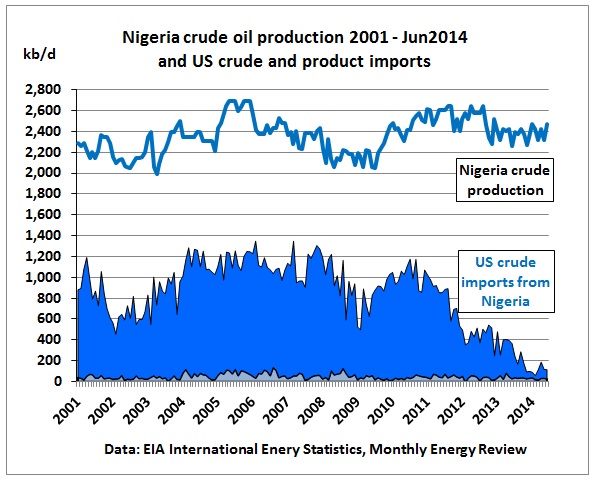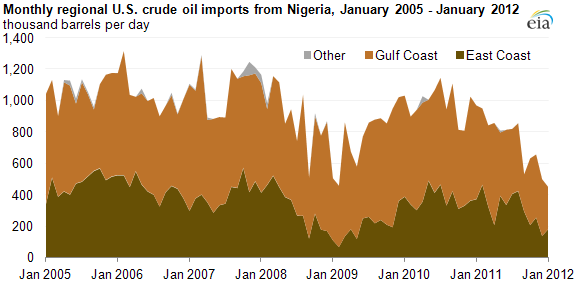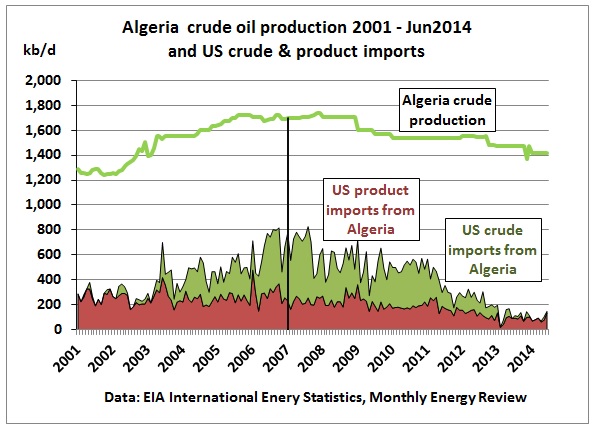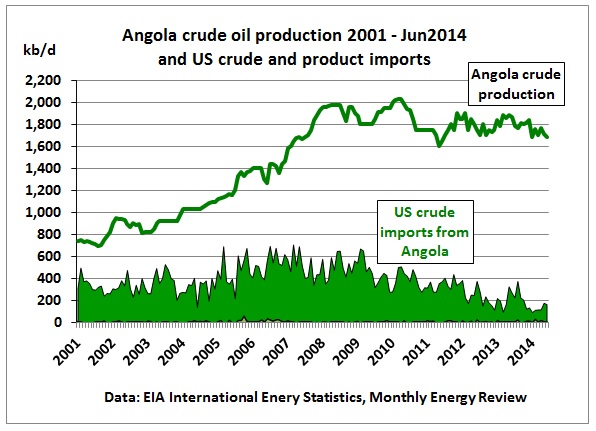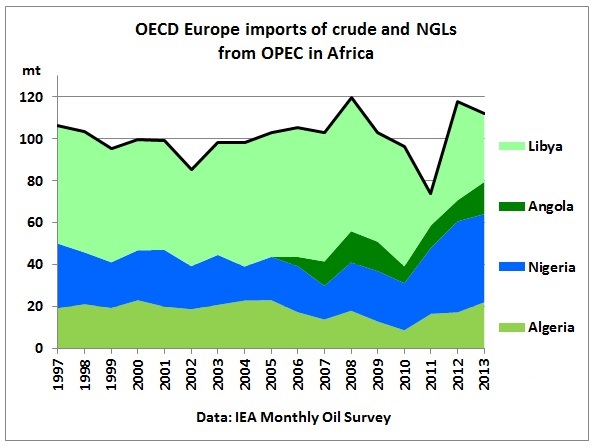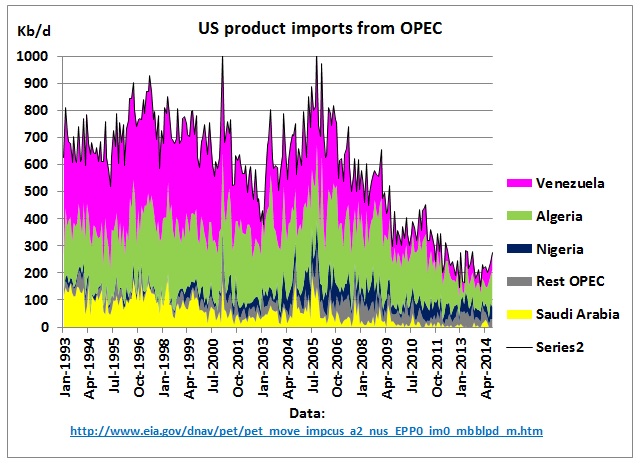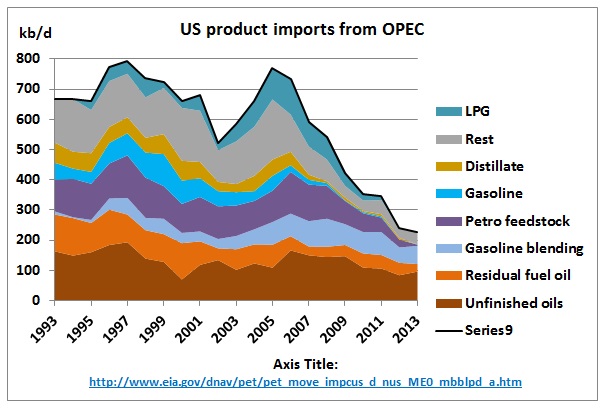This is part 2 of a series of articles on how US tight oil has impacted on oil markets
The following graph shows US petroleum imports from OPEC countries starting in 1960. This includes both crude oil and petroleum products.
Fig 1: US crude oil and product imports from OPEC
Note: Indonesia left OPEC in 2008 but it is included here because most of US imports happened before that year. Indonesia’s oil available for export peaked in 1977, US oil imports from Indonesia peaked one year later in 1978 and Indonesian oil consumption exceeded production since 2004.
Data are from the EIA’s Energy Review page (petroleum section): http://www.eia.gov/totalenergy/data/monthly/#petroleum
After the US peak in 1970 US imports from OPEC increased sharply until 1977 when Iranian oil production peaked and started to decline
Fig 2: Iranian oil production peaked in the mid-70s under the Shah
The next peak in imports was reached in 2007/08 along with a demand peak as described in this article:
22/7/2013 US oil demand peak was in 2007
http://crudeoilpeak.info/us-oil-demand-peak-was-in-2007
Let’s zoom into the period after 2007:
Fig 3: Monthly US oil imports since 2007
Contrary to media reports, US’ dependency on imports from OPEC Middle East suppliers has hardly changed since 2007, the most recent peak year of OPEC imports. A drop in imports from Saudi Arabia can be observed for the crisis year 2009 but total imports from the Middle East recovered in the last 12 months to levels around 12% below 2007/08 levels. Most of the reduction was in imports from Non-Middle-East countries Nigeria, Algeria, Angola and Venezuela.
Fig 4: US oil imports vs Nigeria crude production
US crude imports from Nigeria dropped by around 800 kb/d between 2011 and 2014. Product imports were negligible.
In April 2012 – when imports from Nigeria had already fallen to less than 500 kb/d – EIA wrote an article showing which refineries used Nigerian crude:
Fig 5: US imports from Nigeria by destnation
http://www.eia.gov/todayinenergy/detail.cfm?id=5770
It noted that 2 refineries (Conoco Phillips Trainer -185 kb/d and Sunoco’s Marcus Hook -178 kb/d) which mainly imported expensive, light sweet Nigerian crude were idling since late 2011.
By May 2013, The above East coast refineries had survived by using discounted, light-sweet crude from the Bakken and Eagle Ford fields
http://blogs.platts.com/2013/05/17/us-east-coast-oil-refineries-enjoy-a-stirring-comeback/ .
http://www.eia.gov/countries/cab.cfm?fips=ni
The main beneficiary of declining US imports from Nigeria was Europe which increased imports.
Fig 6: Nigeria crude exports by destination
Fig 7: US oil imports vs Algerian crude production
Algerian crude oil production peaked between 2005 and 2009. Product imports (e.g LPG, unfinished oils and other refinery feedstock) have been declining over the whole period. The 1st phase of declining crude imports from 2007 to 2011 was caused by a weak US economy and the financial crisis, only the 2nd phase by increasing tight oil production. The drop in Algerian crude oil production has worked in the same direction. Again, Europe has benefited most as in 2013, 72% of Algerian crude exports go to Europe.
http://www.eia.gov/countries/analysisbriefs/Algeria/images/crude_oil_exports.png
Fig 8: US oil imports vs Angolan crude production
Angolan crude production seems to have peaked between 2008 and 2010. US crude imports have dropped by around 200 kb/d from 2011. Product imports are negligible.
OECD Europe
Increasing European imports from Nigeria and Angola have at least partially offset production drops from Libya.
Summing it up, imports since 2011 dropped by 800 kb/d (Nigeria), 400 kb/d from Algeria and 200 kb/d from Angola, a total of 1,400 kb/d
Product imports
Fig 6: US imports of products from OPEC
Petroleum product imports from OPEC are in decline since 2005 with a slight additional dip in the financial crisis year 2009, but no particular acceleration of the decline as a result of tight oil. All data are from here:
http://www.eia.gov/dnav/pet/pet_move_impcus_a2_nus_EPP0_im0_mbblpd_m.htm
Fig 7: US product imports from OPEC by product
Distillate fuel oil, gasoline, LPG and petrochemical feedstock have petered out since 2005.
Summary:
US imports started to drop already following the 2007 recession and the financial crisis in 2008. This mainly impacted on countries which anyway had supply problems: Venezuela (depletion of conventional oil and challenges with heavy oil), Nigeria (oil theft) and Algeria (peak oil). When tight oil production took off in 2010/11, these trends continued. US refineries replaced light, sweet crude imports by domestic tight oil. Imports of certain fuels ceased altogether. Dependency on the Middle East was only slightly reduced. The total reduction of US imports between 2011 and 2014 as a result of tight oil is estimated at 1.4 mb/d
In the next article, we’ll look at US product exports
